Quest for Cider - experiments building an apple press
Crabapple pressing experiments
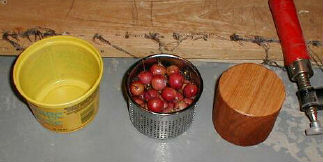 I have these two crabapple trees in my front yard, which every year produce this crop of
very hard little crabapples. These are so hard you cannot crush one with bare hands, and
even stepping on one will not always break them open. My quest began with trying to get a use
for these annoying little crabapples!
I have these two crabapple trees in my front yard, which every year produce this crop of
very hard little crabapples. These are so hard you cannot crush one with bare hands, and
even stepping on one will not always break them open. My quest began with trying to get a use
for these annoying little crabapples!
I started by using the stainless steel strainer from a potato mincer. I made an oak plug
the same diameter as the strainer as the piston, and used a plastic container around
the whole thing to catch the juice.
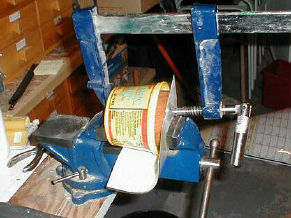 This whole assembly I put in a vise and started turning the screw. I had to add a bar
clamp, because my vise was not big enough to push the piston in the center. The white
plastic is to guide the juice away from the vise, towards a container (not shown).
This whole assembly I put in a vise and started turning the screw. I had to add a bar
clamp, because my vise was not big enough to push the piston in the center. The white
plastic is to guide the juice away from the vise, towards a container (not shown).
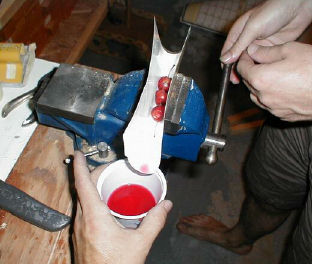
Although this did get a bit of juice to come out, for the quantity of crabapples, it wasn't
very much. Crushing the crabapples three at a time in the vise directly yielded more juice per
crabapple, but obviously is not that effective.
I did however get enough crabapple juice out of this to realize that there was not much
use for it. It tastes more sour than lemon (I don't mind sour) but also bitter. I
couldn't think of anything that I might actually use this juice for, except for maybe
etching the rust off metal or something like that.
Hydraulic press
 I realized that a vise might not be the ideal thing for crushing things. It didn't quite
give me enough force for crabapples, and wasn't large enough to allow experimenting with
apples.
I realized that a vise might not be the ideal thing for crushing things. It didn't quite
give me enough force for crabapples, and wasn't large enough to allow experimenting with
apples.
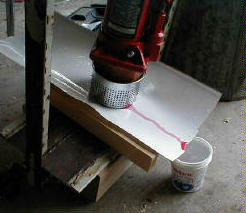 My next move was to buy a six tonne hydraulic jack from Canadian Tire, some angle irons
and built a press out of steel.
My next move was to buy a six tonne hydraulic jack from Canadian Tire, some angle irons
and built a press out of steel.
This got the crabapple juice flowing a little better, although the yield was still a
disappointing. My real goal by then was to crush apples though, the crabapples
were just a test - being plentifully available in my front yard.
So I loaded my little metal basket with one apple and a few extra slices to fill out the
corners, put it under the six ton jack, and started pumping the jack!
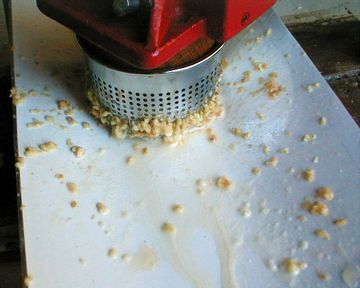 What I got was a bit of juice coming out at first, followed by apple sauce squirting
out the holes. The holes kept getting plugged up by the apple peel, but with more
pressure, the peel would spontaneously give way, causing short jets of apple sauce to
squirt in random directions. Very messy!
What I got was a bit of juice coming out at first, followed by apple sauce squirting
out the holes. The holes kept getting plugged up by the apple peel, but with more
pressure, the peel would spontaneously give way, causing short jets of apple sauce to
squirt in random directions. Very messy!
Normally, cloth is used to keep this sort of thing from happening, so the next load
I wrapped in cotton cloth. Again, I got a little bit of juice, and then no more.
I hadn't nearly maxed out my six ton jack yet, so I applied more force. I'm assuming I applied
several tonnes to the small area. At any rate, the pressure of the apple sauce bulging
out the small holes was too much for the cotton cloth, and it tore around some of
the holes. Of course, this time the pressure was at least three times as much as before,
so the apple bursts went right across the garage!
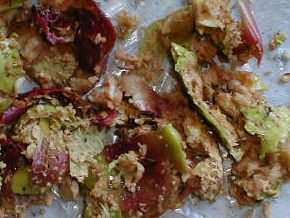 I still didn't get very much juice, unless you count the apple sauce squirted around
everywhere! On opening it up again, I was still able to squeeze some juice out with my
fingers. So I think what happened is that the crushed apple started forming a seal,
trapping the juice inside. Subsequently, All I got was more hydrostatic pressure,
which didn't cause the juice to move anywhere (sort of like a scuba diver doesn't
get his guts squished out even at depth).
I still didn't get very much juice, unless you count the apple sauce squirted around
everywhere! On opening it up again, I was still able to squeeze some juice out with my
fingers. So I think what happened is that the crushed apple started forming a seal,
trapping the juice inside. Subsequently, All I got was more hydrostatic pressure,
which didn't cause the juice to move anywhere (sort of like a scuba diver doesn't
get his guts squished out even at depth).
I suspect this is why
one normally grinds the apples before making cider. But me not having an apple
grinder, I figured I could just make up for it with excessive amounts of force.
To that effect, I substituted much stronger synthetic cloth for the cotton cloth,
and applied an even greater tonnage with my jack.
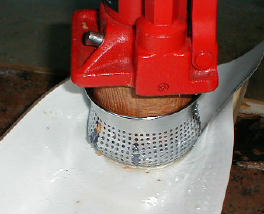 As usual, I got some juice, and then not much more. I applied an incredible amount
of force, the frame for my press straining under pressure. Eventually, the stainless
steel basket from my potato mincer could no longer handle the pressure and the steel
tore on the sides, bulging from the pressure.
The cloth held back the jets of apple sauce though, so the failure was disappointingly
unspectacular. No bang, no squirts, just metal slowly tearing.
As usual, I got some juice, and then not much more. I applied an incredible amount
of force, the frame for my press straining under pressure. Eventually, the stainless
steel basket from my potato mincer could no longer handle the pressure and the steel
tore on the sides, bulging from the pressure.
The cloth held back the jets of apple sauce though, so the failure was disappointingly
unspectacular. No bang, no squirts, just metal slowly tearing.
The extra pressure really didn't give me noticeably more juice. Beyond a certain
pressure, there just wasn't any more juice coming out, no matter how much more
force I applied. Examining the remains after squishing, the remaining bits still
produced a bit of liquid even if I squished them with my bare fingers.
I resigned myself to not being able to get that high a yield without grinding the
apples up, and I just didn't have anything to grind the apples with before pressing.
Bigger press
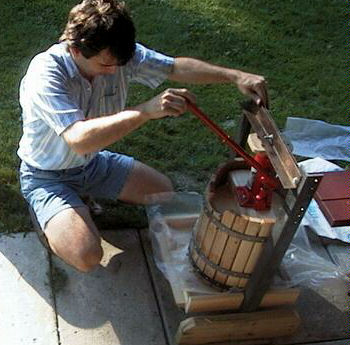
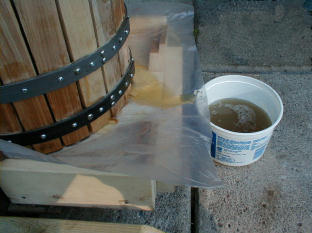
Seeing that the extra force beyond a moderate point only resulted in more destruction,
but not more juice. I figured I might as well build a bigger container to hold
more apples. Besides, my potato mincer was already busted and I needed a new container.
I built a nice big bucket sized wooden barrel like container, with slots between the
wooden staves for the juice to get out. The barrel is open on both ends. It sits
on top of a flat tray which catches the juice. I didn't make my tray watertight, but
used some plastic foil to guide the juice out with instead.
The juice soon started flowing and I managed to press around two liters of pure
juice out of the load of apples. This wasn't a very high yield, and I kept applying
more pressure.
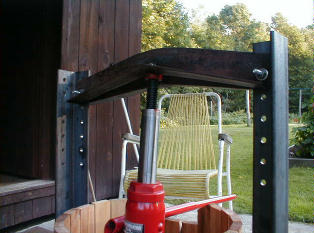
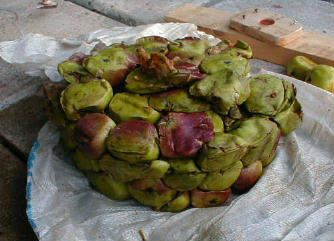
Parts of my steel frame began to strain and eventually the angle irons I used
as the top crossbeam failed. Actually, what really failed was that the bolt I used
to hold them together tore apart, and so they moved apart and my jack just went
in between them.
The juice yield per quantity of apples was even more disappointing. The apples
still had a bit of their original shape, although they did adapt in shape to perfectly
occupy the volume and shape of my container. By this time, I was quite confident
that grinding up of the apples in some way is something that is necessary. I don't think
my poor juice yield was due to a lack of force at any rate!
Those experiments happened in 1999. Four years later, in 2003, I built an
Apple Grinder. The results of the apple grinder
were very encouraging, and it makes it clear that getting good yield out of apples
for juice is less a matter of how much pressure in the press, and more of how well
the apples are ground before they go into the press.
I left the press at my parents. My dad "modified" my press to a wooden frame,
you can see it used here. My dad's modifications consisted
of getting rid of everything I built and replacing it with a sturdy hardwood frame.
The only part he kept was the hydraulic jack, which I hadn't built!
 This whole assembly I put in a vise and started turning the screw. I had to add a bar
clamp, because my vise was not big enough to push the piston in the center. The white
plastic is to guide the juice away from the vise, towards a container (not shown).
This whole assembly I put in a vise and started turning the screw. I had to add a bar
clamp, because my vise was not big enough to push the piston in the center. The white
plastic is to guide the juice away from the vise, towards a container (not shown).

 I have these two crabapple trees in my front yard, which every year produce this crop of
very hard little crabapples. These are so hard you cannot crush one with bare hands, and
even stepping on one will not always break them open. My quest began with trying to get a use
for these annoying little crabapples!
I have these two crabapple trees in my front yard, which every year produce this crop of
very hard little crabapples. These are so hard you cannot crush one with bare hands, and
even stepping on one will not always break them open. My quest began with trying to get a use
for these annoying little crabapples!
 I realized that a vise might not be the ideal thing for crushing things. It didn't quite
give me enough force for crabapples, and wasn't large enough to allow experimenting with
apples.
I realized that a vise might not be the ideal thing for crushing things. It didn't quite
give me enough force for crabapples, and wasn't large enough to allow experimenting with
apples.
 My next move was to buy a six tonne hydraulic jack from Canadian Tire, some angle irons
and built a press out of steel.
My next move was to buy a six tonne hydraulic jack from Canadian Tire, some angle irons
and built a press out of steel.
 What I got was a bit of juice coming out at first, followed by apple sauce squirting
out the holes. The holes kept getting plugged up by the apple peel, but with more
pressure, the peel would spontaneously give way, causing short jets of apple sauce to
squirt in random directions. Very messy!
What I got was a bit of juice coming out at first, followed by apple sauce squirting
out the holes. The holes kept getting plugged up by the apple peel, but with more
pressure, the peel would spontaneously give way, causing short jets of apple sauce to
squirt in random directions. Very messy!
 I still didn't get very much juice, unless you count the apple sauce squirted around
everywhere! On opening it up again, I was still able to squeeze some juice out with my
fingers. So I think what happened is that the crushed apple started forming a seal,
trapping the juice inside. Subsequently, All I got was more hydrostatic pressure,
which didn't cause the juice to move anywhere (sort of like a scuba diver doesn't
get his guts squished out even at depth).
I still didn't get very much juice, unless you count the apple sauce squirted around
everywhere! On opening it up again, I was still able to squeeze some juice out with my
fingers. So I think what happened is that the crushed apple started forming a seal,
trapping the juice inside. Subsequently, All I got was more hydrostatic pressure,
which didn't cause the juice to move anywhere (sort of like a scuba diver doesn't
get his guts squished out even at depth).
 As usual, I got some juice, and then not much more. I applied an incredible amount
of force, the frame for my press straining under pressure. Eventually, the stainless
steel basket from my potato mincer could no longer handle the pressure and the steel
tore on the sides, bulging from the pressure.
The cloth held back the jets of apple sauce though, so the failure was disappointingly
unspectacular. No bang, no squirts, just metal slowly tearing.
As usual, I got some juice, and then not much more. I applied an incredible amount
of force, the frame for my press straining under pressure. Eventually, the stainless
steel basket from my potato mincer could no longer handle the pressure and the steel
tore on the sides, bulging from the pressure.
The cloth held back the jets of apple sauce though, so the failure was disappointingly
unspectacular. No bang, no squirts, just metal slowly tearing.




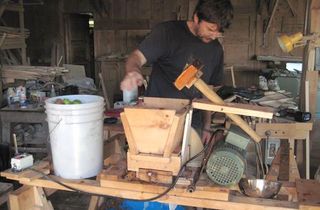 Making apple cider
Making apple cider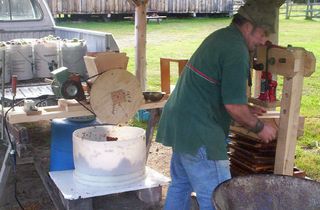 My parents making apple cider
My parents making apple cider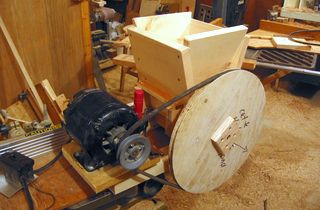 Apple grinder, first version
Apple grinder, first version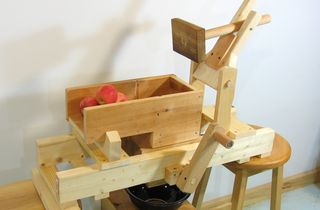 Apple grinder, second version
Apple grinder, second version